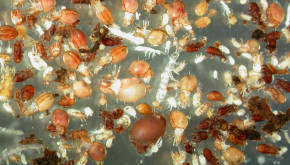
Written by Coeli Hoover
The next time you’re in the woods, take a good look around. Now, close your eyes and imagine a dark and mysterious world filled with strange and wonderful creatures. Open your eyes and look down...that world is beneath your feet. Aboveground, photosynthesis drives the forest ecosystem that you see around you. Below ground, in the forest floor and the soil, decomposition plays that role. When you look around, you see producers (plants), consumers (insects and critters of various sorts) and if you’re lucky, a glimpse of a predator (maybe even a bobcat).  Underfoot, the cast of characters changes a little, with decomposers (bacteria and fungi) taking the place of producers, and consumers look quite a bit different. We are all familiar with earthworms, but there are all sorts of amazing creatures, many too small to see without a microscope. Mites roam, collembola (springtails) leap through the leaf litter on the forest floor, and nematodes are here, there, and everywhere, to name just a few kinds of soil fauna. Rotifers live in lakes, yes, but also in the thin film of water that surrounds soil particles. There are predators as well; pseudoscorpions look so fierce that I, for one, am grateful that they are not larger, and some predatory mites are quite impressive. My favorite soil resident is the tardigrade, or water bear. These amazing creatures also live in the water film on soil particles, and survive by remaining dormant in dry conditions. This amazing little creature has been around for at least 500 million years, and can survive just about anything (even being blasted into space)!
Underfoot, the cast of characters changes a little, with decomposers (bacteria and fungi) taking the place of producers, and consumers look quite a bit different. We are all familiar with earthworms, but there are all sorts of amazing creatures, many too small to see without a microscope. Mites roam, collembola (springtails) leap through the leaf litter on the forest floor, and nematodes are here, there, and everywhere, to name just a few kinds of soil fauna. Rotifers live in lakes, yes, but also in the thin film of water that surrounds soil particles. There are predators as well; pseudoscorpions look so fierce that I, for one, am grateful that they are not larger, and some predatory mites are quite impressive. My favorite soil resident is the tardigrade, or water bear. These amazing creatures also live in the water film on soil particles, and survive by remaining dormant in dry conditions. This amazing little creature has been around for at least 500 million years, and can survive just about anything (even being blasted into space)!
So, what’s going on below ground? We know that energy flows and nutrients cycle through ecosystems and a lot of that work happens downstairs. Energy flows - fallen leaves and trees are broken down by the decomposer community, and part of the carbon contained in this wood and litter (which was the sun’s energy, captured and stored during photosynthesis) powers the underground food web, while part of it is incorporated into the soil, increasing water holding capacity, reducing bulk density, and building soil structure, among other things. Nutrients cycle- our forests keep a tight rein on their budgets, and elements like nitrogen, phosphorus, potassium, calcium, and magnesium are not always easy to come by. Mineral weathering is slow, and while trees can meet some of their needs from nutrients dissolved in rainwater, decomposing leaves are a key source of the nutrients that our forests need to grow and thrive. How do these nutrients become available to tree roots? Through the actions of our busy decomposer community. The next time you are out in the woods, take a minute to look around and remember that everything that you see around you is supported by the mysterious and wonderful world beneath your feet, the soil ecosystem.
For more on collembola (including video of them jumping) and tardigrades, check out these links:
https://www.youtube.com/watch?v=OwOL-MHcQ1w
http://www.bbc.com/earth/story/20150313-the-toughest-animals-on-earth
Soil fauna photo courtesy of Dr. Uffe Nielsen, University of Sydney, Australia
Coeli Hoover, PhD is a research ecologist with the Forest Service Northern Research Station


